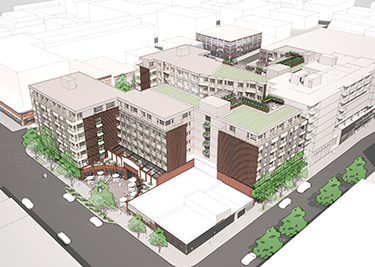|
Subscribe / Renew |
|
|
Contact Us |
|
| ► Subscribe to our Free Weekly Newsletter | |
| home | Welcome, sign in or click here to subscribe. | login |
Architecture & Engineering
| |
 |
October 31, 2013
A&E 2013 Surveys: Weber Thompson
Specialty: Architecture, community/urban design, interior design, landscape architecture
Management: Blaine Weber, Scott Thompson, Kristen Scott
Founded: 1988
Headquarters: Seattle
2013 revenues: $9 million
Projected 2014 revenues: $11 million
Projects: 2030 Eighth Ave. apartments; Pike Motorworks apartments; Kirkland TOD; Yesler Terrace Phase IIa for Seattle Housing Authority
Weber Thompson principals Blaine Weber, Scott Thompson and Kristen Scott discussed their firm, its projects and what’s ahead for Seattle:
Q: How do you see the development cycle playing out?
Weber: We now find ourselves in the most robust housing cycle experienced in the last 20 years. Thanks to strong local job growth and new household formation, we believe this current housing cycle has some serious legs.
The advisories that we get from market prognosticators like Brian O’Connor and Mike Scott indicate that the market can absorb more units than the current “pipeline” has in the queue, at least for the foreseeable future.
As the pendulum swings, we will of course see an oversupply of housing, but these experts are predicting that vacancy is unlikely to exceed 5 percent, at least through 2016.
Meanwhile, the commercial office and hospitality markets are waking up.
Q: What’s your biggest business challenge?
Scott: Maintaining a diversity of project types in the office. Coming out of the mortgage-driven recession, there is a surge of apartment projects and we have such a depth of experience in this building type that there is a lot of interest in our firm.
To mitigate future market changes, we are balancing this with other project types. We are focusing our efforts on bringing hospitality and commercial projects to the firm and are seeing a great deal of success with this.
Q: Any behind-the-scenes developments at Weber Thompson?
Thompson: As we celebrate our 25th anniversary, we are looking to the next generation of leadership. We have promoted and hired exceptional talent, creating a strong team of professionals dedicated to design and technical quality, collaboration and client care. And frankly, as a founder of the firm, it is a blast working with and mentoring this group of young talent.
Q: What are a couple of major trends in residential design?
Weber: In housing, the mega-trend in play is that more people are embracing an urban lifestyle, whereby they live, work and play in the city center — in fact, more people live in cities now than at any time in history, and this trend is here to stay.
In housing, there is a definite pull away from providing private decks in deference to generous amenity packages that are socially focused and that serve as “third places.”
Gen Y is a “force majeure” that will determine the future of the housing market. They are looking for housing solutions that cater to their mobile- and technology-focused lifestyles.
Another big trend is that housing units continue to shrink, challenging architects to design small, efficient units that feel and live “large” in spite of their size.
Q: What do architects have to consider when their projects shape the communities in which they’re built?
Thompson: Along with our clients, architects and urban planners have a tremendous influence in shaping the future of our neighborhoods. How a building touches the ground, breaks down, respects its neighbors and meets the 21st-century challenges of livability, affordability and environmental impact is always a balancing act.
The end user is highly important to us. We realize that they will spend a good amount of their time interacting with our designs, and their lifestyle and needs are something we think seriously about. We also realize that no building exists in a vacuum — it is part of the greater fabric, and our designs need to take into consideration what is beyond our property line.
Ramping up into this current construction cycle, our firm has had the good fortune of working with some very forward-thinking developers that want to create legacy projects and contribute to the vitality of our communities.
Other Stories:
- ‘Standard of care’ is all about reasonable expectations
- A&E 2013 Surveys: Runberg Architecture Group
- A&E 2013 Surveys: PAE Consulting Engineers
- A&E 2013 Surveys: Freiheit & Ho Architects
- A&E 2013 Surveys: Fossatti Pawlak Structural Engineers
- A&E 2013 Surveys: Hewitt
- A&E 2013 Surveys: GGLO
- Architecture: It’s not science, it’s art
- Designing a waterfront entrance for Pike Place Market
- Now hear this: ADA updates listening device rules
- Tech influence ripples across the design world
- Can’t find a lender? Try crowdfunding
- A&E 2013 Surveys: BergerABAM



